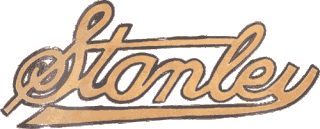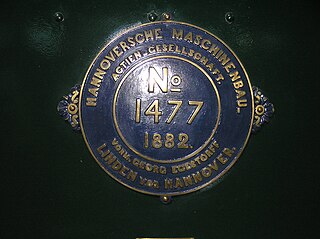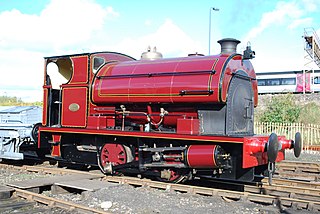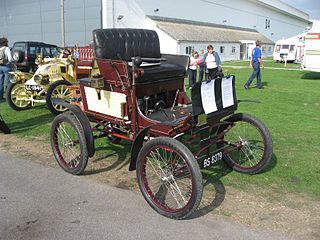| Look up locomobile in Wiktionary, the free dictionary. |
Locomobile may refer to:
| Look up locomobile in Wiktionary, the free dictionary. |
Locomobile may refer to:
The Locomobile Company of America was a pioneering American automobile manufacturer founded in 1899, and known for its dedication to precision in the pre-assembly-line era. It was one of the earliest car manufacturers in the advent of the automobile age. For the first two years after its founding, the company was located in Watertown, Massachusetts. Production was transferred to Bridgeport, Connecticut, in 1900, where it remained until the company's demise in 1929. The company manufactured affordable, small steam cars until 1903, when production switched entirely to internal combustion-powered luxury automobiles. Locomobile was taken over in 1922 by Durant Motors and eventually went out of business in 1929. All cars ever produced by the original company were always sold under the brand name Locomobile.
Haulage is the business of transporting goods by road or rail. It includes the horizontal transport of ore, coal, supplies, and waste, also called cartage or drayage. The vertical transport of the same with cranes is called hoisting.

A traction engine is a self-propelled steam engine used to move heavy loads on roads, plough ground or to provide power at a chosen location. The name derives from the Latin tractus, meaning 'drawn', since the prime function of any traction engine is to draw a load behind it. They are sometimes called road locomotives to distinguish them from railway locomotives – that is, steam engines that run on rails.

For Want of a Nail: If Burgoyne Had Won at Saratoga is an alternate history novel published in 1973 by the American business historian Robert Sobel. The novel depicts an alternate world where the American Revolution was unsuccessful. Although it is fiction, the novel takes the form of a work of nonfiction, specifically an undergraduate-level history of North America from 1763 to 1971. The fictional history includes a full scholarly apparatus, including a bibliography of 475 works and 860 footnotes citing imaginary books and articles; three appendices listing the leaders of the Confederation of North America, the United States of Mexico and Kramer Associates; an index; a contemporary map of the alternate North America; and a preface thanking imaginary people for their assistance with the book. The book also includes a critique of itself by Professor Frank Dana, an imaginary Mexican historian with two books listed in the bibliography.

A road train or land train is a trucking vehicle of a type used in rural and remote areas of Australia, the United States and in Europe to move freight efficiently. It consists of two or more trailers or semi-trailers hauled by a prime mover.

A locomotive or engine is a rail transport vehicle that provides the motive power for a train. If a locomotive is capable of carrying a payload, it is usually rather referred to as multiple units, motor coaches, railcars or power cars; the use of these self-propelled vehicles is increasingly common for passenger trains, but rare for freight.
| This disambiguation page lists articles associated with the title Locomobile. If an internal link led you here, you may wish to change the link to point directly to the intended article. |

The American Locomotive Company built locomotives, diesel generators, steel and tanks. The company was formed in 1901 by the merger of Schenectady Locomotive Engine Manufactory of Schenectady, New York, with seven smaller locomotive manufacturers. The American Locomotive Automobile Company subsidiary designed and manufactured automobiles under the Alco brand from 1905 to 1913 and produced nuclear energy from 1954 to 1962.

A diesel locomotive is a type of railway locomotive in which the prime mover is a diesel engine. Several types of diesel locomotive have been developed, differing mainly in the means by which mechanical power is conveyed to the driving wheels.

Horseless carriage is an early name for the motor car or automobile. Prior to the invention of the motor car, carriages were usually pulled by animals, typically horses. The term can be compared to other transitional terms, such as wireless phone. These are cases in which a new technology is compared to an older one by describing what the new one does not have.

The Brass Era is an American term for the early period of automotive manufacturing, named for the prominent brass fittings used during this time for such things as lights and radiators. It is generally considered to encompass 1896 through 1915, a time when these vehicles were often referred to as horseless carriages.

The Stanley Motor Carriage Company was an American manufacturer of steam-engine vehicles; it operated from 1902 to 1924. The cars made by the company were colloquially called Stanley Steamers, although several different models were produced.

A steam car is a car (automobile) propelled by a steam engine. A steam engine is an external combustion engine (ECE) in which the fuel is combusted outside of the engine, unlike an internal combustion engine (ICE) in which fuel is combusted inside the engine. ECEs have a lower thermal efficiency, but carbon monoxide production is more readily regulated.
Émile Delahaye was a French automotive pioneer who founded Delahaye Automobiles.

Otto August Kuhler was an American designer, one of the best known industrial designers of the American railroads. According to Trains magazine he streamstyled more locomotives and railroad cars than Cret, Dreyfuss and Loewy combined. His extensive concepts for the modernization of the American railroads have repercussions onto the railways worldwide until today. In addition he was a prolific artist of industrial aesthetics and of the American West in general.

Hanomag was a German producer of steam locomotives, tractors, trucks and military vehicles in Hanover. Hanomag first achieved international fame by delivering a large number of steam locomotives to Finland, Romania and Bulgaria before World War I and making of first tractor Hanomag R26 in 1924 in Germany. In 1925, they added automobiles to their line, additionally moving in 1931 into the production of construction machinery. Since 1989, the company has been part of the Komatsu company.

Peckett and Sons was a locomotive manufacturer at the Atlas Locomotive Works on Deep Pit Road between Fishponds and St. George, Bristol, England.
MÁVAG was a Hungarian rail vehicle producer. MÁVAG company was the second largest industrial enterprise after the Manfréd Weiss Steel and Metal Works in the Hungarian half of the Austro-Hungarian Monarchy. MÁVAG was the property of the Kingdom of Hungary. After the World War II MÁVAG was nationalized, and "Királyi" ("Royal") was removed from its name.
Road locomotive could refer to:

Thomas Green & Son, Ltd. were engineers who manufactured a wide range of products at the Smithfield Foundry, Leeds, United Kingdom.

Advanced steam technology reflects an approach to the technical development of the steam engine intended for a wider variety of applications than has recently been the case. Particular attention has been given to endemic problems that led to the demise of steam power in small- to medium-scale commercial applications: excessive pollution, maintenance costs, labour-intensive operation, low power/weight ratio, and low overall thermal efficiency; where steam power has generally now been superseded by the internal combustion engine or by electrical power drawn from an electrical grid. The only steam installations that are in widespread use are the highly efficient thermal power plants used for generating electricity on a large scale. In contrast, the proposed steam engines may be for stationary, road, rail or marine use.

The history of steam road vehicles comprises the development of vehicles powered by a steam engine for use on land and independent of rails, whether for conventional road use, such as the steam car and steam waggon, or for agricultural or heavy haulage work, such as the traction engine.

The Mobile Company of America was an American steam automobile manufacturer founded in 1899 by John B. Walker after a fallout with businessman Amzi L. Barber, whose financing had earlier allowed Walker to purchase the now well-known Stanley Steamer concern. It was based in Tarrytown, New York.

Stearns Steam Carriage Company (1901–1904) was a manufacturer of steam automobiles in Syracuse, New York, founded by Edward C. Stearns, an industrialist. Stearns built his first automobile in 1899, an electric which sold so few models through 1900 that the firm changed to steam power in 1901 when the company was incorporated. The company was also known as the Stearns Automobile Company.
The New York Locomotive Works, sometimes known as the Rome Locomotive Works, was a nineteenth century builder of steam locomotive engines located at Rome, New York. The company was active under various ownerships in building steam locomotives from 1882 until 1911. The New York Locomotive Works should not be confused with the earlier Breese, Kneeland, and Company which traded under the same name in the 1850s. The company was organized in 1881 with T. G Noch, a prominent local businessman as president. J. A. Durgan, a well known designer of steam locomotives was appointed superintendent, a position he had previously held at the Rhode Island Locomotive Works. The company was an instant success, as railroads were expanding a feverish pace. NYLW offered a robust, no frills locomotive and was well connected with banking interests that allowed sales along the "Car Trust Plan" with payments out to ten years.